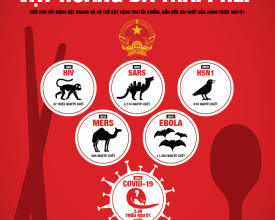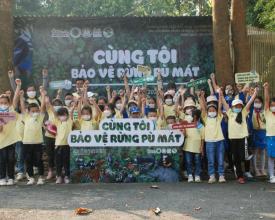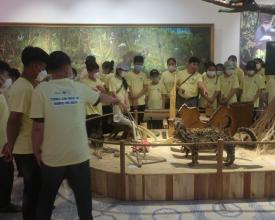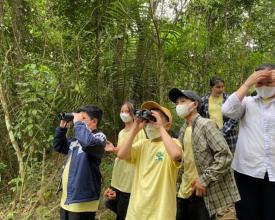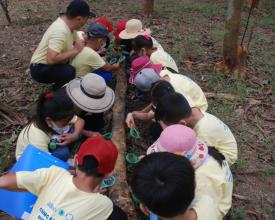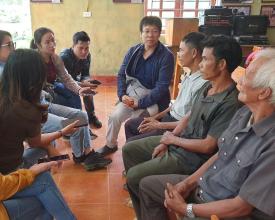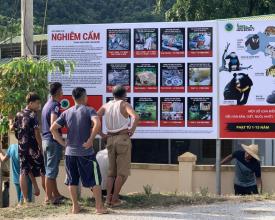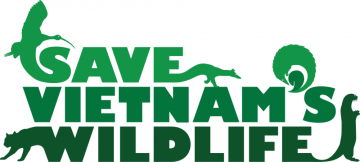
Sensibilisation à l'éducation pour enrayer la perte de biodiversité et soutenir le développement durable des communautés autour du parc national de Pu Mat, au Viêt Nam

Les populations indigènes, le gouvernement local, les négociants en espèces sauvages et les consommateurs d'espèces sauvages jouent tous un rôle important dans la réussite des objectifs et des stratégies de conservation autour du parc national de Pu Mat, à Nghe An, au Viêt Nam. Les populations indigènes locales dépendent des ressources forestières et certaines sont également impliquées dans le commerce illégal d'espèces sauvages. Pour réduire l'impact négatif des communautés sur les forêts, nous avons mis en place des programmes scolaires, un engagement communautaire et des activités visant à modifier les comportements. Le programme a permis aux écoliers de mieux comprendre l'importance du parc national de Pu Mat et de toutes les espèces sauvages qui s'y trouvent. À la fin de notre projet, les enfants étaient prêts à choisir des emplois qui n'avaient pas d'impact sur les forêts. Un tiers des personnes en âge de travailler dans les villages ont quitté les villages pour chercher un emploi dans les usines au lieu de pénétrer dans les forêts et de chasser les animaux, et plus de 35 % des parties prenantes participantes ont dit "non" à la consommation d'animaux sauvages.
Contexte
Défis à relever
De nombreux écosystèmes d'Indochine sont confrontés à une crise d'extinction. Un large éventail de populations d'espèces endémiques et essentielles sont en déclin en raison du commerce illégal d'espèces sauvages.
- Le problème est d'autant plus difficile à résoudre que le commerce illégal d'espèces sauvages implique des populations locales, qui sont souvent des minorités ethniques appauvries
- Étant donné que les parcs nationaux autorisent toujours les populations locales à pénétrer dans les forêts et à collecter des produits non ligneux au Viêt Nam, cette activité pourrait causer de graves dommages à la biodiversité et menacer l'existence des animaux sauvages lorsqu'elle est pratiquée à des fins commerciales.
- Les populations locales se rendent dans les forêts pour installer des pièges et des collets sans discernement, ce qui permet de capturer et de vendre toutes les espèces piégées.
- À l'origine, de nombreuses populations locales vivaient à l'intérieur de la forêt. Les politiques de relocalisation volontaire du gouvernement vietnamien ont convaincu de nombreuses communautés de vivre en dehors de la forêt ; cependant, elles dépendent encore largement des ressources forestières
- Les principaux consommateurs d'espèces sauvages sont souvent des personnes riches et haut placées, y compris des fonctionnaires.
Emplacement
Traiter
Résumé du processus
Les activités humaines constituent la principale menace pour la faune et la flore au Viêt Nam, et leur impact découle souvent d'un manque de sensibilisation, de connaissances et d'attitudes négatives à l'égard de la faune et de la flore. Grâce à ses programmes d'éducation, le SVW a ciblé plusieurs parties prenantes issues de différents secteurs du public. Nos programmes ont été conçus en fonction des besoins spécifiques de chaque groupe ciblé, ainsi que des exigences de conservation de nos espèces clés. L'évaluation des besoins des parties prenantes permet d'identifier ce à quoi elles répondent le mieux, et les interventions de suivi exploitent ces réponses pour personnaliser les activités de changement de comportement.
Les enfants sont encouragés à prendre des mesures appropriées pour protéger la faune et la flore qu'ils aiment, ce qui promet une génération future dans les zones tampons avec des attitudes et des comportements positifs à l'égard de la faune et de la flore. À l'avenir, les communautés locales se verront proposer d'autres moyens de subsistance ou seront initiées à d'autres options de travail afin de réduire leur impact négatif sur les ressources naturelles. Enfin, les programmes de changement de comportement réduisent la demande de produits issus de la faune et de la flore sauvages.
Blocs de construction
Programme scolaire
Sensibiliser et éduquer la communauté, en particulier les enfants de la zone tampon du parc national de Pu Mat, est l'une des stratégies à long terme de la SVW qui vise à former une génération future avec des attitudes et des comportements positifs envers la faune et la flore tout en réduisant l'exploitation non durable des ressources naturelles. Notre programme "Rejoignez-moi pour protéger les forêts de Pu Mat" est conforme au programme d'éducation à l'environnement mis en œuvre dans les écoles par le ministère vietnamien de l'éducation et de la formation, ainsi qu'aux politiques générales du gouvernement dans le domaine de la conservation de la nature et de la gestion de la faune et de la flore sauvages. Plus de 4 500 élèves du primaire et du secondaire de la zone tampon du parc national de Pu Mat ont participé à ce programme, ce qui leur a permis d'acquérir davantage de connaissances et de contribuer fièrement à la protection du parc national de Pu Mat dans la mesure du possible. Des affiches visuelles, des manuels et d'autres matériels ont été distribués aux écoles pour continuer à faire passer le message de la conservation.
Facteurs favorables
Le programme comprend cinq activités différentes :
- Des recherches sociales ont été menées avant et après le programme afin d'en évaluer l'impact
- Un club d'étudiants a été créé dans chaque école.
- Un programme de diffusion a été lancé dans les écoles, encourageant les élèves à faire entendre leur voix.
- Nos excursions d'une journée ont permis aux membres des clubs et aux élèves qui ont participé activement au programme de se rendre au parc national de Pu Mat pour y découvrir la faune et la flore, afin de les inspirer et de les encourager à agir.
Leçon apprise
- La différence de niveau cognitif des écoliers de différents âges, en particulier ceux des régions isolées, doit être prise en compte lors de l'élaboration du contenu et du matériel des activités. Des méthodes éducatives multiples devraient être adoptées pour créer des approches plus diversifiées pour les élèves d'âges différents.
- Les conditions météorologiques défavorables dans les zones locales peuvent perturber le déroulement des activités, en particulier celles qui nécessitent une interaction en personne. Lorsque ces événements malheureux se produisent, il est préférable de faire preuve de souplesse et de préparer soigneusement des plans de secours à l'avance.
- Les flambées compliquées et imprévisibles de la pandémie de COVID-19 au Viêt Nam ont été le facteur le plus important qui a eu un impact sur le programme. Le transfert des activités sur des plateformes en ligne peut être une solution, mais il faut également tenir compte de l'accessibilité des étudiants dans les régions éloignées. Les plans de secours doivent toujours être soigneusement préparés à l'avance.
Ressources
Programme d'engagement communautaire
Le travail avec les communautés locales dans les zones tampons du parc national de Pu Mat est l'un des principaux objectifs de SVW, afin de les sensibiliser, de réduire leur impact sur les ressources forestières et de les inciter à protéger la faune et la flore. Nous utilisons diverses approches pour mettre en œuvre différents programmes, qu'il s'agisse d'organiser des ateliers d'engagement communautaire et des formations, de placer de grands panneaux d'affichage autour des zones tampons ou d'utiliser des outils d'éducation autonomes pour encourager les populations locales à prendre des mesures informées pour protéger la faune et la flore.
Facteurs favorables
- De nombreux ateliers communautaires ont été organisés dans les bastions de la faune et les points chauds du braconnage autour du parc national de Pu Mat, avec la participation des villageois locaux.
- Le SVW a installé des panneaux d'affichage de grande taille pour sensibiliser la population à l'entrée de la forêt et dans d'autres zones.
- une émission de radio bilingue sur la faune et la flore à l'intention de la communauté vivant dans la zone tampon du parc
- Une trousse de sensibilisation pratique a été élaborée à l'intention de l'équipe de lutte contre le braconnage et des gardes forestiers du parc, afin qu'ils puissent l'emporter et l'utiliser pour discuter avec les gens au cours de leurs patrouilles ou de leurs réunions avec la communauté.
Leçon apprise
- Un grand nombre de personnes dans les régions reculées des zones tampons sont analphabètes, c'est pourquoi tout le matériel pédagogique doit être simple et comporter de nombreuses images.
- Lors de l'élaboration des activités, la participation des communautés locales doit être prise en considération afin d'accroître l'efficacité des programmes d'engagement communautaire.
- Après une série d'activités d'engagement communautaire, le SVW vise à développer des moyens de subsistance alternatifs appropriés pour les communautés locales.
Changement de comportement
Le changement de comportement est l'une des principales composantes de notre action en faveur de la conservation de la faune et de la flore sauvages. Cette composante du projet vise à modifier le comportement des consommateurs d'espèces sauvages en identifiant les comportements clés et en les utilisant pour réduire la demande de produits issus d'espèces sauvages. Les résultats de la recherche de base sur la sensibilisation et les attitudes des fonctionnaires et des citoyens autour du parc national de Pu Mat à l'égard de la consommation et de la vente de viande sauvage ont été utilisés pour développer des interventions appropriées de changement de comportement, en attirant l'attention sur l'impact de la consommation de viande sauvage sur la santé et sur les perceptions sociales négatives de la consommation de viande sauvage. Après la mise en œuvre de notre travail, l'impact de nos messages sur les comportements d'évitement et les attitudes à l'égard de la consommation de viande sauvage a été mesuré.
Facteurs favorables
- Recherche basée sur des entretiens sur le commerce de la viande sauvage et les restaurants dans la zone du projet et documentation pertinente transmise aux chercheurs sur le changement de comportement.
- Une campagne de changement de comportement a été conçue et mise en œuvre dans la zone du projet : un événement de lancement de la campagne, un panneau d'affichage et une campagne d'affichage ont été installés dans des lieux centraux et sur les routes principales. En outre, tous les fonctionnaires ont signé un engagement à ne pas utiliser d'espèces sauvages illégales.
- Évaluation des impacts initiaux avant et après le projet.
Leçon apprise
- La planification du projet doit être plus soigneusement étudiée afin d'éviter les chevauchements d'agenda avec le gouvernement local. L'équipe doit s'efforcer d'élaborer un plan détaillé de demande d'approbation et de mise en œuvre qui évite les périodes d'activité intense du gouvernement.
- Le contenu et l'image utilisés sur chaque matériel de campagne doivent être soigneusement étudiés afin de minimiser les controverses et les questions politiquement sensibles. Tous les contenus et images utilisés pour l'intervention ont été examinés et ajustés avec soin avant l'installation, conformément aux recommandations de l'équipe de consultants et du gouvernement.
- La campagne et ses messages devraient être diffusés par des moyens de communication plus diversifiés afin d'en améliorer la portée et l'efficacité.
- Le matériau des panneaux d'affichage doit être étudié avec soin afin de garantir leur résistance aux conditions météorologiques extrêmes du Viêt Nam et aux accidents inattendus.
Impacts
Programme scolaire
-
Après le programme, 92,13 % des élèves interrogés ont répondu correctement à la question sur la connaissance de la faune et de la flore.
-
98 % des élèves du club ont exprimé leur choix de ne pas participer à des emplois qui dépendent des forêts de Pu Mat, tels que l'exploitation forestière, les produits forestiers et la chasse, lorsqu'ils seront adultes.
-
90,38 % des élèves interrogés ont été informés des activités auxquelles ils pouvaient participer pour protéger les forêts de Pu Mat après le programme.
Programme d'engagement communautaire
-
Un tiers des personnes en âge de travailler ont quitté les villages où se sont déroulés nos ateliers d'engagement communautaire pour chercher un emploi après le Nouvel An lunaire 2019, grâce au renforcement de l'application de la loi et aux ateliers d'éducation communautaire.
-
Plusieurs grands panneaux d'affichage, ainsi que nos kits d'information, ont été signalés pour aider le département local de protection des forêts du parc national de Pu Mat à sensibiliser davantage la population aux besoins de conservation de la faune et de la flore sauvages et à la législation forestière.
Changements de comportement
-
Le nombre de participants disposés à éviter de consommer des produits à base de viande sauvage a augmenté de 36 %.
-
Après la mise en œuvre de l'intervention, un nombre croissant de personnes ont désapprouvé la consommation de viande sauvage.
-
Après l'intervention, les participants pensaient que moins de personnes au Viêt Nam consommaient de la viande sauvage et que la société désapprouvait davantage la consommation de viande sauvage.
-
Après l'intervention, la viande sauvage a été jugée plus susceptible de causer des maladies que la viande non sauvage, par rapport à la situation antérieure à l'intervention.
Bénéficiaires
Population locale
Autorités locales (comité populaire de la province ou du district, département de la protection des forêts de la province ou du district)
Responsables du parc national et conseil de gestion
Secteur commercial, par exemple les restaurants
La faune et la flore du parc national de Pu Mat
Objectifs de développement durable
Histoire
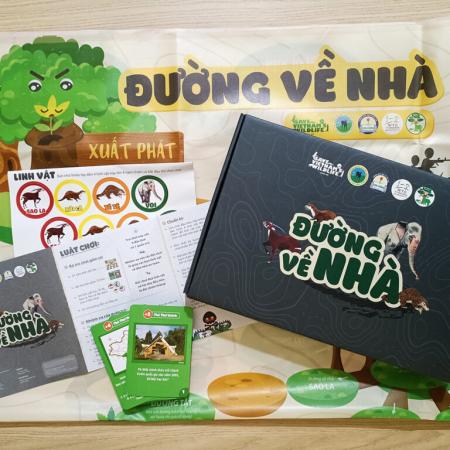
En raison de la pandémie de COVID-19, nous n'avons pas été en mesure d'organiser des assemblées dans les écoles pour notre événement annuel sur la conservation. Nous avons élaboré plusieurs plans de secours, notamment un jeu de société intitulé "The Way Home" et un concours d'écriture.
Notre jeu de société "The Way Home" vise à promouvoir la créativité et l'interactivité et devrait permettre aux enfants de s'amuser tout en apprenant des informations utiles sur la nature et la faune de Pu Mat. Le jeu emmène les élèves dans les voyages du pangolin, de la loutre, du saola et de l'éléphant à travers les pièges dangereux des chasseurs dans la forêt pour rentrer chez eux sains et saufs. L'avantage de ce jeu est que les enseignants peuvent le réutiliser plusieurs fois, pour de nombreux élèves de différentes cohortes. Le jeu a été très apprécié par les élèves et les enseignants. Après avoir joué pour la première fois, un élève nous a fait part de son expérience : "C'est la première fois que mes amis et moi jouons à un jeu sur les animaux sauvages. J'aime beaucoup ce jeu parce qu'il est beau et qu'il contient beaucoup d'informations sur la nature et les animaux sauvages qui peuvent m'être utiles".
Le concours d'écriture que nous avons organisé a dépassé nos espérances, puisqu'environ un mois après le lancement du concours, nous avons reçu plus de 1 000 inscriptions, soit un cinquième de l'ensemble des élèves de la zone tampon du parc national de Pu Mat. C'est un résultat incroyable pour nous, car il prouve que notre programme a eu une grande portée dans les communautés qui entourent le parc national de Pu Mat.

